![]()
![]()
![]()
Use LEFT and RIGHT arrow keys to navigate between flashcards;
Use UP and DOWN arrow keys to flip the card;
H to show hint;
A reads text to speech;
48 Cards in this Set
- Front
- Back
|
which stage of the cardiac cycle corresponds with the QRS peak in the EKG?
|
Isovolumic Contraction Phase
|
|
|
which cardiac cycle phase does this describe?
Rise in ventricular pressure following atrial contraction. |
Isovolumic Contraction Phase
|
|
|
what causes the first heart sound?
|
movement of blood against the atrio-ventricular valves
|
|
|
why is there an increase in atrial and aortic pressure during the Isovolumic Contraction Phase?
|
because as the pressure builds the valve bulge into the atria and aorta causing increased pressure in these areas
|
|
|
what causes the venous "c" pulse?
|
the pressure from the pushing of the tricuspid valve up into the atria during the Isovolumic Contraction Phase is transmitted to the venous return
|
|
|
the end of the Isovolumic Contraction Phase is marked by what?
|
ventricular pressure reaching aortic pressure
|
|
|
what marks the beginning of the rapid ejection phase?
|
the ventricular pressure exceeding the aortic pressure causing the semilunar valves to open
|
|
|
after the semilunar valve opens describe the pressure change in the ventricle?
|
it continues to increase and is mirrored by the aortic pressure
|
|
|
which cardiac cycle phase does this describe?
Sharp fall in ventricular blood volume and a sudden increase in aortic blood flow? |
rapid ejection phase
|
|
|
which two cardiac cycle phases correspond to the "c" pulse?
|
rapid ejection and isovolumic contraction phases
|
|
|
describe the reduced ejection phase?
|
the blood flow from the ventricle reduces and maximum contraction is reached and a slow reduction in pressure is seen in the ventricle and aorta.
|
|
|
what is the blood remaining in the ventricle after it has completed the ejection phase called?
|
residual volume
|
|
|
if the residual volume is equal or greater than the stroke volume what can be said for the heart?
|
it is beginning or already is failing
|
|
|
if the residual volume is less than the stroke volume what can be said for the heart?
|
it is a normally functioning heart as far as the amount of blood being expelled
|
|
|
what marks the beginning of the isovolumic relaxation phase?
|
closing of the semilunar valves, as aortic pressure exceeds ventricular pressure
|
|
|
during which phase of the cardiac cycle is the second heart sound heard?
|
the isovolumic relaxation phase
|
|
|
what phase of the cardiac cycle corresponds to the T wave of the electrocardiogram?
|
the isovolumetric relaxation phase
|
|
|
what is responsible for the venous "v" pulse?
|
atrial filling backs up venous return increasing venous blood pressure
|
|
|
what marks the end of the isovolumic relaxation phase?
|
opening of the atrioventricular valves
|
|
|
which phase is initiated upon the opening of the mitral and tricuspid valves?
|
the rapid ventricular filling phase
|
|
|
describe the pressure changes seen in the atria and ventricles during the the rapid ventricular filling phase?
|
both areas experience a pressure drop as blood moves from the atria to the ventricles (seems kinda wrong cause the ventricles are filling, but remember that while the valves are open the areas they connect share pressure changes)
|
|
|
what causes the third heartbeat that can sometimes be heard?
|
blood rushing into the heart hitting the residual volume in the ventricles
|
|
|
under what condition will it be most likely a third heart sound will be observed?
|
when the residual volume of the heart is high
|
|
|
what is another name for the third heart sound?
|
a diastolic gallop
|
|
|
what is the cardiac phase which is reduced during rapid HR?
|
diastases (reduced ventricular filling stage)
|
|
|
what phase of the cardiac cycle begins with the peak of the P-wave in an EKG?
|
atrial systole phase
|
|
|
what results in the venous "a" pulse?
|
atrial systole
|
|
|
what causes the 4th heart sound?
|
small vibrations caused by atrial systole
|
|
|
while atrial systole is not essential for ventricular filling, when does it become most important?
|
during increased HR when the diastasis (reduced ventricular filling phase is reduced)
|
|
|
what is the pathology of Aortic stenosis?
|
flaps of the aorta are fused due to scarring which decreases the crossectional area for blood to leave the left ventricle into the aorta
|
|
|
what is the halmark sign of aortic stenosis?
|
the ventricular pressure greatly exceeds the aortic pressure when the aortic valve is open
|
|
|
what does a aortic stenosis sound like?
|
sustained blowing murmur that is heard throughout ventricular systole
|
|
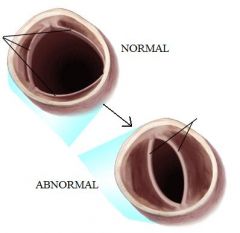
what murmur would be associated with this pathology?
|
aortic stenosis
|
|
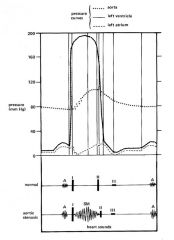
What pathological process leads to this result?
|
Aortic Stenosis
|
|
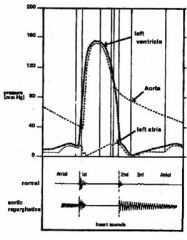
What pathological process could lead to this result?
|
aortic regurgitation
|
|
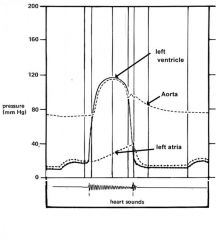
What pathological process could lead to this result?
|
Mitral valve regurgitation
|
|
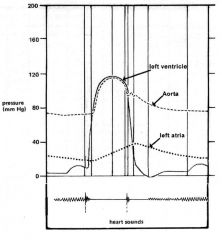
What pathological process could lead to this result?
|
Mitral valve stenosis
|
|
|
what is the hallmark feature of mitral stenosis?
|
atrial pressure greatly exceeds ventricular pressure during diastole when the mitral valve is open
|
|
|
what is heard with a mitral valve stenosis?
|
low blwoing murmur that begins midway through diastole and is loudest with atrial systole
|
|
|
what is the hallmark feature of aortic regurgitation?
|
An unusualy drop in aortic pressure during ventricular diastole reaching values of 40 mm Hg rather than the typical value of 80 mm Hg
|
|
|
describe the pressure values in the left ventricle and atria with aortic regurgitation?
|
the ventricular pressure is greater than the atrial pressure thus making it very difficult to keep blood moving through the heart
|
|
|
what does aortic regurgitation sound like?
|
a loud blowing murmur that occurs throughout ventricular diastole
|
|
|
if a murmur increases with inspiration what side of the heart is it on?
|
the right because venous return increases on inspiration
|
|
|
does inspiration or expiration increase left ventricular stroke volume?
|
expiration
|
|
|
how could a patient make a mitral or aortic valve regurgitation louder?
|
prolonged deep expiration
|
|
|
during inspiration which valve closes first? The aortic or pulmonic?
|
the aortic vavle because there is more blood in the right ventricle and it takes longer for it to be pumped out thus the pulmonic valve is delayed in closing (splitting of S2 is heard)
|
|
|
which valve closes first during expiration? The aortic or pulmonic?
|
TRICK the both normally close at the same time during expiration this the is no splitting of S2
|
|
|
a splitting of S1 and S2 with the S2 splitting increasing with inspiration would indicate?
|
right bundle branch block
|

